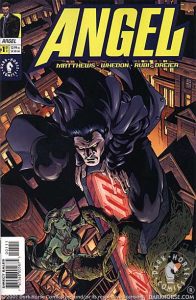Under the suggestion of Joss Whedon, Dark Horse shut down its “Angel” series in April 2001, then relaunched it a few months later with the four-issue “Long Night’s Journey” (September 2001-May 2002), which presumably was to be the start of another long-running volume but turned out to be one-series-and-done.
The idea, aggressively executed by Mel Rubi (pencils) and Chris Dreier (inks), was that – unlike the original series that hewed closely to the TV series – comicdom’s Angel would be a true four-color superhero, doing things that would be impossible on TV. The title has a new logo that looks a bit like the modern “Avengers” movie logo, as Whedon bluntly signals that this ain’t your cozy little brooding-detective show.
After an establishing page of Los Angeles, Angel flies into the frame from out of the sky, crashing into a demon’s car for a multi-page fight to get this party started. Cordelia is drawn with particular emphasis on her, um, attributes – and I’m not talking about her acting skills. Everyone is in character, although Wesley and Gunn (this story is set in early Season 2) have a touch more heroic swagger than on TV. Issue 1 wraps with Angel fighting a green supermodel/serpent, who seems to be of the same demon race as Willow’s girlfriend from the post-TV-show comics, plus a lava monster who could crush the Beast from Season 4 with one footstep. The artists use far more large panels and splash pages than in Volume 1.
“Long Night’s Journey” succeeds at being visually and kinetically big, but under the pen of Brett Matthews (later of the “Serenity” comics) and Whedon, it’s a bit cold at first in comparison to the original series, which emphasized Angel’s ennui and the loneliness of Cordy, Doyle and Wesley. Some scenes take place in the Hyperion Hotel, but it doesn’t feel like the warm home base of the TV show.
However, the writers dig out of the hole in a big way as the story moves forward, with an intriguing twist to the mythology: The gypsies cursed Angel with a soul as a practice run for performing the curse on Zheng, a vampire whom Angel met in the 1920s and who is terrorizing the gang here.
While the curse worked on Angel, it did not work on Zheng, giving the latter a bizarre case of jealousy. This twist allows those who like to embrace the cuddly side of Angel to imagine that he was receptive to a soul because of an innate goodness that Zheng lacks. On the other hand, the TV series has shown us that Liam (Angel as a human) was not a great guy, and Zheng throws out this tidbit with his dying words: “The soul, Angel. Are you very sure that it’s yours?”
“Long Night’s Journey” concludes with two suggestions that this was not supposed to be the end of “Angel” Volume 2: Angel is confident they’ll hear from the supermodel/serpent again, and a final page shows us the father of the kid Angel rescues earlier in the story is a religious fanatic determined to “make” people see that angels are real.

For whatever reason, though, “Angel” would disappear from comic racks for three years, not returning until IDW stepped in to fill the void left by the TV show’s cancellation. IDW’s “Angel” issues ran the gamut of styles, but generally didn’t embrace the superhero style. Still, “Long Night’s Journey’s” influence lingers, along with that of Whedon’s future-Slayer saga “Fray” (2001-03). Modern “Buffy” and “Angel” comics – though certainly not as action-packed as “Long Night’s Journey” – are more apt to embrace their superhero side than before Whedon tried out this experiment.
Click here for an index of all of John’s “Buffy” and “Angel” reviews.

